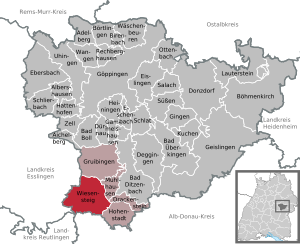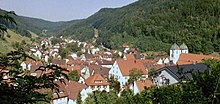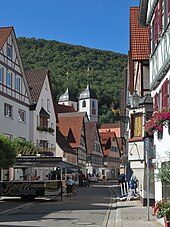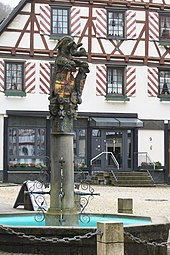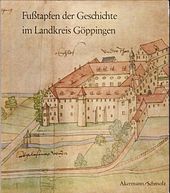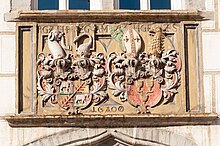Wiesensteig
| coat of arms | Germany map | |
|---|---|---|

|
Coordinates: 48 ° 34 ' N , 9 ° 38' E |
|
| Basic data | ||
| State : | Baden-Württemberg | |
| Administrative region : | Stuttgart | |
| County : | Goeppingen | |
| Height : | 592 m above sea level NHN | |
| Area : | 23.4 km 2 | |
| Residents: | 2065 (Dec. 31, 2018) | |
| Population density : | 88 inhabitants per km 2 | |
| Postal code : | 73349 | |
| Area code : | 07335 | |
| License plate : | GP | |
| Community key : | 08 1 17 058 | |
| LOCODE : | DE WNA | |
City administration address : |
Hauptstrasse 25 73349 Wiesensteig |
|
| Website : | ||
| Mayor : | Gebhard Tritschler | |
| Location of the town of Wiesensteig in the district of Göppingen | ||
Wiesensteig is a town in the district of Göppingen ( Stuttgart administrative district ) in Baden-Württemberg , in the very south-east of the Stuttgart region .
geography
Wiesensteig is located in the upper Filstal at an altitude of 575 to 750 meters in the district of Göppingen . On the outskirts of the city, the Alb ascent of the A 8 runs towards Ulm .
City structure
Wiesensteig includes the town of Wiesensteig, the Bläsiberg, Eckhöfe, Heidental, Reußenstein and Ziegelhof farms and the Lämmerbuckel and Papiermühle houses as well as the abandoned towns of Michelnbuch and Schafhaus.
Neighboring communities
Neighboring communities are Gruibingen in the north, Mühlhausen in the Täle in the northeast, Drackenstein in the east, Hohenstadt in the southeast, Westerheim ( Alb-Donau district ) in the south, Römerstein ( Reutlingen district ) in the southwest and Lenningen in the west and Neidlingen (both Esslingen district ) in the north-west.
Division of space

According to data from the State Statistical Office , as of 2014.
history
Until the 19th century
Wiesensteig is first mentioned in a document in 861, when a Benedictine monastery was founded there, from which a canon monastery emerged in 1103 , which existed until the secularization of 1803. The traces of settlement, however, go back to the Stone Age .
The town has had town charter since 1356. At that time it was subordinate to the Counts of Helfenstein . Since 1512 the rule Wiesensteig was assigned to the Swabian Empire within the Holy Roman Empire .
Count Ulrich XVII. von Helfenstein (1524–1570) and his brother Sebastian († 1564) introduced the Lutheran creed in Wiesensteig in 1555. Between 1562 and 1611 at least 111 women and a man in the context of the rule were in Wiesensteig witch-hunting as " witches and fiends executed". 1567 returned Count Ulrich XVII. returned to the Catholic Confession and carried out a Counter-Reformation . The municipal council of the city of Wiesensteig decided on January 30th, 2017 the socio-ethical rehabilitation of the victims of the witch trials.
In 1648 the town was almost completely burned down by Swedish soldiers. After the Helfenstein family died out in 1627, two thirds of the imperial county Wiesensteig (through three heir daughters) fell in 1642 through purchase to Kurbayern and one third to the princes of Fürstenberg , who also sold their share to Kurbayern in 1752. Through an exchange of territory, the city came to the Kingdom of Württemberg in 1806 and became the seat of the Oberamt Wiesensteig. This was dissolved in 1810 and Wiesensteig was subordinated to the Geislingen District Office. During the administrative reform during the Nazi era in Württemberg , Wiesensteig came to the Göppingen district in 1938. After the Second World War, the city came under the American zone of occupation and thus belonged to the newly founded state of Württemberg-Baden , which was incorporated into the current state of Baden-Württemberg in 1952.
Population development
Source: Baden-Württemberg State Statistical Office for data from 1970
| date | Residents |
|---|---|
| 1837 | 1496 |
| 1907 | 1327 |
| May 17, 1939 | 1683 |
| September 13, 1950 | 2063 |
| May 27, 1970 | 2632 |
| December 31, 1983 | 2490 |
| May 25, 1987 | 2426 |
| December 31, 1991 | 2575 |
| December 31, 1995 | 2445 |
| December 31, 2000 | 2350 |
| December 31, 2005 | 2312 |
| December 31, 2010 | 2138 |
| December 31, 2015 | 2056 |
politics
Administrative association
Together with Mühlhausen im Täle , Drackenstein , Gruibingen and Hohenstadt , the city has formed the Upper Filstal Municipal Administration Association with its headquarters in Wiesensteig since 1972 .
Municipal council
The municipal council in Wiesensteig has 12 members. The turnout in the local elections on May 26, 2019 was 62.04% (2014: 59.7%) and resulted in the following distribution of seats:
| Open candidate list | 50.69% | 6 seats |
| Citizens for Wiesensteig | 43.03% | 5 seats |
| Neutral list | 6.28% | 1 seat |
The municipal council consists of the elected voluntary councilors and the mayor as chairman. The mayor is entitled to vote in the municipal council.
mayor
Gebhard Tritschler (independent) was elected full-time mayor in January 2010. The predecessor was Klaus-Dieter Apelt.
coat of arms
The coat of arms shows "in red a silver elephant growing out of a golden five-mountain ". The first evidence comes from the year 1482 from an imprint of a city seal, which shows an elephant growing out of a sloping four-mountain, the heraldic animal of the earlier city lords, the Count of Helfenstein . While the growing elephant is always to be found in all subsequent representations (e.g. the first color illustration from 1560) of the city's coat of arms, the number of domes changed between one and five. In one case, the elephant even emerges directly from the edge of the shield. Since 1930, however, the Fünfberg has been used as a coat of arms. Until 1958 the flag colors were green-red. Since this combination violates the Heraldic Color Rules, the colors white-red were awarded by the Ministry of the Interior on February 4, 1959.
Economy and Infrastructure
traffic

Via the state road 1200, Wiesensteig has a connection to the federal road 466 and the federal highway 8 . Wiesensteig lies on the Swabian Albstraße . The Albaufstieg of the A 8 motorway passes above the village .
From 1903 to 1968 Wiesensteig was connected to the railway network by the valley railway from Geislingen an der Steige . The Royal Württemberg State Railways built the station building as a type IIIb unit station .
education
With the Franz-Xaver-Messerschmidt School, Wiesensteig has a primary school .
Culture and sights
Buildings
- Residential castle of the Helfensteiner (1551): The castle was built in 1551-1555 by Count Ulrich XVII. Built with four wings in the Renaissance style and was the residence of the Counts of Helfenstein -Gundelfingen until 1627 . In the Fürstenberg and Bavarian times it served as the administrative center. In 1812 it was demolished except for the existing south wing, after which it was used as a warehouse, residential building, notary's office, doctor's office and post office. 1983 - 1986 it was completely renovated. Since then it has been used for cultural events. The "alliance coat of arms" of Count Rudolf VI is located above the main portal. and his wife Anna Maria von Staufen from 1600.
- Collegiate Church of St. Cyriakus (1466) with Weigle organ from 1849
- Market place with elephant fountain and half-timbered houses
- Kreuzkapelle north of Wiesensteig on the Alb plateau. The footpath to the chapel is lined with stations of the cross.
- Reußenstein ruins , about 5 km northwest of Wiesensteig
- Wiesensteig transmitter
- Directional radio reversing tower
Natural monuments
- Filsursprung , about two kilometers southwest of Wiesensteig
Sports
Ski Area
With the Bläsiberg ski area, Wiesensteig has the largest ski area in the Swabian Alb. It includes three tow lifts and approx. 5 km of slopes with different levels of difficulty.
TSV Obere Fils
TSV Obere Fils was founded on June 24th, 1972 through the merger of the two clubs TSV Wiesensteig and TSV Mühlhausen. Sports facilities are the club house on the sports field in Wiesensteig, the school gym and the old gym in the center of Wiesensteig. The community hall and the old sports field in Mühlhausen are also used.
Personalities
sons and daughters of the town
- 1704, June 1, Johann Baptist Straub , † July 15, 1784 in Munich, important sculptor of the Upper Bavarian Rococo
- 1736, February 6, Franz Xaver Messerschmidt , † August 19, 1783 in Pressburg, sculptor
- 1764, January 25, Felix Joseph von Lipowsky , † March 21, 1842 in Munich, lawyer
- 1764, July 23, Johann Baptist von Schiber , † March 28, 1829 in Landshut, lawyer
- 1932, March 15, Erno Seifriz , † April 4, 2012, music educator, music historian and choirmaster
- 1949, December 20, Franz Steinle Jurist (former President of the Higher Regional Court of Stuttgart), sports official (President of the German Ski Association)
Other personalities associated with Wiesensteig
- Jakob Henrichmann (around 1482–1561), humanist, lawyer and clergyman, provost of Wiesensteig
- Thaddäus Ferdinand Lipowsky (1738–1767), civil servant and musician, cameraman and judicial officer in Wiesensteig, composed regularly for the local canon monastery
literature
- Wiesensteig in old pictures. Editing and compilation by Franz Naumann. Geiger, Horb am Neckar, 1990, ISBN 3-89264-475-6 .
- Siegfried Hermle, Reformation and Counter-Reformation in the Reichsgrafschaft Wiesensteig . Anton H. Konrad Verlag, Weißenhorn, 1996, ISBN 978-3-87437-391-3 .
Web links
Individual evidence
- ↑ State Statistical Office Baden-Württemberg - Population by nationality and gender on December 31, 2018 (CSV file) ( help on this ).
- ^ The state of Baden-Württemberg. Official description by district and municipality. Volume III: Stuttgart District, Middle Neckar Regional Association. Kohlhammer, Stuttgart 1978, ISBN 3-17-004758-2 , pp. 345-347.
- ↑ State Statistical Office, area since 1988 according to actual use for Wiesensteig.
- ↑ Warholy and terrible deeds and acts of the LXIII. Witches and fiends, as in Wisenstaig, who were judged with the Brandt, n.d. [Nuremberg: Friedrich Gutknecht] 1563.
- ↑ Der Teckbote, edition of February 4, 2017, page 18
- ↑ Cf. Siegfried Hermle: Reformation and Counter-Reformation in the Wiesensteig rule with special consideration of the contribution by Jakob Andreae (sources and research on the history of the church in Württemberg 14), Stuttgart: Calwer 1996; Siegfried Hermle, Reformation and Counter-Reformation in the Reichsgrafschaft Wiesensteig . Weißenhorn: Anton H. Konrad Verlag, 1996, ISBN 978-3-87437-391-3 .
- ↑ Wiesensteig rehabilitates its witches
- ↑ http://www.swp.de/goeppingen/lokales/landkreis_gp/im-rahmen-einer-stadtfuehrung-wurde-in-wiesensteig-das-mittelalter-lebendig-10480760.html
- ^ Rainer Stein: The Württemberg standard station on branch lines . In: Eisenbahn-Journal Württemberg-Report . tape 1 , no. V / 96 . Merker, Fürstenfeldbruck 1996, ISBN 3-922404-96-0 , p. 80-83 .
- ↑ www.ulmer-orgeln.de
- ↑ www.skilifte-wiesensteig.de

